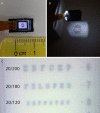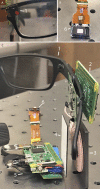Feasibility of Intraocular Projection for Treatment of Intractable Corneal Opacity
- PMID: 30664047
- PMCID: PMC6407816
- DOI: 10.1097/ICO.0000000000001852
Feasibility of Intraocular Projection for Treatment of Intractable Corneal Opacity
Abstract
Despite many decades of research and development, corneal opacity remains a leading cause of reversible blindness worldwide. Corneal transplantation and keratoprosthesis can restore corneal clarity, but both have well-known limitations. High-resolution electronic microdisplays may offer an alternative to traditional methods of treating corneal disease using an intraocular implant to project imagery onto the retina, obviating the need for a clear cornea. In this study, we review previous work and recent technologic developments relevant to the development of such an intraocular projection system.
Conflict of interest statement
The authors have no funding or conflicts of interest to disclose.
Figures





References
-
- Gain P, Jullienne R, He Z, et al. Global survey of corneal transplantation and eye banking. JAMA Ophthalmol. 2016;134:167–173. - PubMed
-
- Bartels MC, Doxiadis II, Colen TP, et al. Long-term outcome in high-risk corneal transplantation and the influence of HLA-A and HLA-B matching. Cornea. 2003;22:552–556. - PubMed
-
- Saeed HN, Shanbhag S, Chodosh J. The Boston keratoprosthesis. Curr Opin Ophthalmol. 2017;28:390–396. - PubMed
-
- Lee WB, Shtein RM, Kaufman SC, et al. Boston keratoprosthesis: outcomes and complications: a report by the American Academy of Ophthalmology. Ophthalmology. 2015;122:1504–1511. - PubMed
-
- Iyer G, Srinivasan B, Agarwal S, et al. Boston type 2 keratoprosthesis-mid term outcomes from a tertiary eye care centre in India. Ocul Surf. 2018. (ePub ahead of print). - PubMed
Publication types
MeSH terms
Grants and funding
LinkOut - more resources
Full Text Sources
Other Literature Sources

